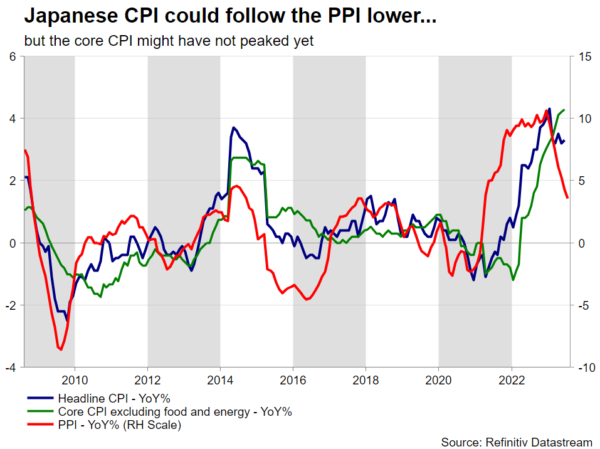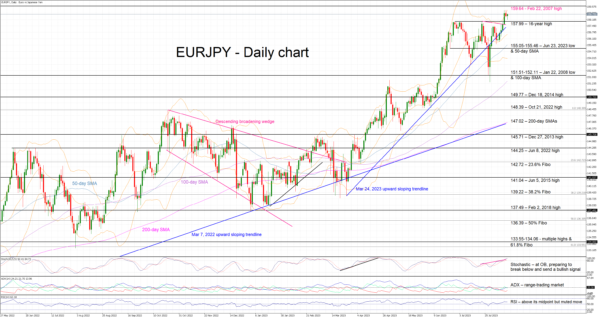Japanese data releases continue unabated by the summer lull as this week’s calendar includes the preliminary GDP print for the second quarter of 2023 and the July national inflation report. Barring a plethora of upside data surprises, only the resurfacing of the intervention rumours could provide a helping hand to the yen, especially against the euro.
BoJ is still on the sidelines
Following the disappointing July 28 meeting, the BoJ appears to observe a quiet period of analysing incoming data and preparing for the usually market-moving and thought-provoking Jackson Hole gathering held in late-August. With the yen suffering from the lack of significant BoJ announcements, but the 10-year Japanese bond behaving well lately, there is a growing possibility of intervention rumours taking over the market again. While the US dollar-yen pair is the key factor in the Ministry of Finance’s decision to order such an intervention, euro-yen is getting dangerously close to testing the February 22, 2007 high of 159.64 and thus raising a few eyebrows at the MoF halls.
Maybe data releases could offer some reprieve
Amidst this environment, the economic data calendar is rather full this week. On Tuesday, we will get the preliminary GDP result for the second quarter of 2023. The market is expecting another impressive report with the annualized figure seen at 3.1%, up from 2.7% in the previous quarter.
As a comparison, the preliminary US GDP print came at 2.4% YoY quarterly annualized growth and Germany recorded another negative quarter, with the euro area aggregate figures kept in positive territory due to the strong performance of France. Interestingly, these mixed GDP results raise questions on the likely global growth figures achieved if China manages to overcome its current domestic issues. Maybe this week’s Chinese data could finally offer some further valuable insight on the underlying economic developments there.
Returning to the Japanese data, and the BoJ hawks are probably smiling after last week’s decent labour cash earnings print. This is one of the few bright spots in the data calendar but clearly not enough to push the BoJ into announcing a much-discussed rate hike. Only the inflation report possesses this unique power and on Friday we will be updated on the national inflation figures for the month of July.
While the headline CPI did not reach levels seen in both the US and the euro area, it remains at a respectable rate and not that far from its recent peak of 4.3% YoY growth. Some early market forecasts point to a 2.5% YoY increase for July, but there is some positive momentum coming from the producer price index (PPI) recording strong yearly increases, despite its recent easing trend.
From the BoJ’s perspective, it is crucial for the headline figures to remain around 3%. An extended series of 3% inflation prints could gradually be engraved in the public’s mind, eventually allowing the BoJ to escape from its extra loose monetary policy stance.
The market’s eyes will also be on the two core indicators published with the national CPI component, excluding food, seen rising by 3.1% in July, a tad below its June 2023 high of 3.3%. Interestingly, when examining Chart 1 below, it is obvious that there is a considerable time lag, around 9–15 months to be more precise, between the headline PPI and the core CPI indicator (excluding food and energy). This probably means that this indicator might not have peaked yet and thus some sort of policy tightening could still be on the table.
Euro-yen at record high
The yen continues to suffer against most developed-market currencies. The euro-yen pair made a new 16-year high and looks ready to test the February 22, 2007 high at 159.64. This performance is clearly the product of the divergent monetary policy strategies and the BoJ’s unwillingness to keep the door open to a hawkish rate move down the road. A strong set of data releases this week could allow for a small pullback below the recent 157.99 high, but the yen needs a lot more to reverse the current strong bullish trend in euro-yen.















